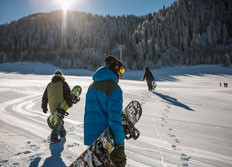
Wrist fractures are a commonly seen in snowboarders with over 100,000 wrist fractures due to snowboarding any given year. They are more common in beginners because they often occur when someone falls and tries to brace their fall by reaching out their hand to break their fall.
The wrist is made up of eight small bones which connect with the two long forearm bones called the radius and ulna. A broken wrist can happen in any of these 10 bones but most commonly occurs in one of the forearm bones (called the radius).

There are different types of wrist fractures. Some are considered “non-displaced” which means the bones do not move out of place. Some are “displaced” breaks (which need to be put back into the right place, called “reduction” or “setting.” Fractures can also be considered either stable or unstable. Stable fractures can be treated in a cast or splint. Unstable fractures sometimes need surgery.
Immediate signs that can indicate a broken wrist include pain, swelling, and difficulty moving your hand or wrist. To diagnose a fracture the doctor will usually do an X-ray. Depending on the location of the suspected fracture the doctor may need to do a CT scan or MRI scan to get a better detail and visualization of the fracture fragments and other injuries.
Treatment will depend on the severity of the fracture. Some fractures can be treated with a splint or cast. If a fracture is more serious it may require surgery. A VERY important thing to remember during recovery is to keep your fingers moving to keep them from getting stiff. This is necessary to help you recover full motion, strength and function. Unfortunately, it is not unusual for recovery to take months.
To help prevent wrist injuries when skiing don’t fall…
All jokes aside – wrist guards, found in ski shops, can help reduce the chance of wrist injury during falls (we all do it).
*The views and opinions expressed herein are those of the author and do not necessarily reflect the views of MDLingo.com, its affiliates, or its employees.